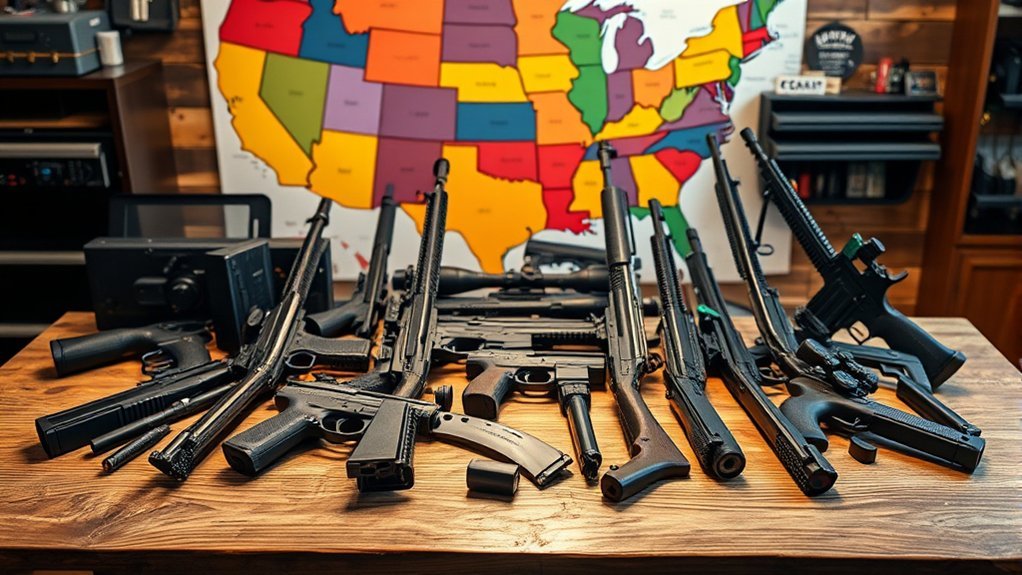Firearm storage laws vary widely across the U.S., impacting youth safety considerably. In some states, strict Child Access Prevention policies mandate secure storage, while others lack any regulations. This inconsistency raises critical questions about the effectiveness of current measures. Understanding these differences is essential for evaluating the risk of unauthorized access to firearms. What implications do these laws have for families and communities?
Overview of Secure Storage Laws
Secure storage laws play an essential role in preventing unauthorized access to firearms, especially by minors. These laws, which vary considerably across states, mandate that firearms be securely stored to mitigate risks associated with youth gun violence. Currently, 26 states have enacted Child Access Prevention policies, while 24 states lack such regulations, leaving critical gaps in firearm storage safety. Definitions of “child” often range from under 14 to under 18, with specific conditions triggering compliance. Research shows that households implementing secure storage measures experience up to 85% fewer unintentional injuries involving firearms. Public awareness campaigns and legal consequences for non-compliance are crucial for promoting adherence, ultimately enhancing community safety and reducing the tragic impact of youth gun violence.
States With Adopted Policies

Several states have recognized the importance of secure firearm storage and implemented laws to prevent unauthorized access, particularly by minors. A total of 26 states have adopted Child Access Prevention policies, which mandate secure storage practices to safeguard firearms from children under 18. Notable examples include California, Colorado, Connecticut, Delaware, and Florida, where laws specify penalties for non-compliance. Research shows that proper firearm storage can reduce unintentional injuries among children by up to 85%, emphasizing the critical role these laws play in enhancing community safety. By ensuring firearms are securely stored, these states aim to greatly lower the risk of accidental access and protect vulnerable populations, ultimately fostering a safer environment for families.
States Without Adopted Policies

While many states have recognized the importance of firearm storage laws, a significant number, including Alabama, Alaska, Arizona, Arkansas, and Georgia, lack any formal policies aimed at preventing unauthorized access to firearms. These 26 states do not have specific legal requirements for securely storing firearms, which increases the risk of accidental access by children and unauthorized individuals. Without mandated storage practices for Child Access Prevention, families may lack guidance on safe firearm storage. This absence can lead to higher rates of firearm-related incidents among youth. Research shows that states with secure storage laws tend to have lower rates of accidents and youth suicides, underscoring the public safety implications of not having such regulations in place.
Definitions of “Child” in Firearm Laws
The definitions of “child” in firearm laws vary considerably across states, impacting how firearm storage regulations are applied. For instance, Florida and New Jersey define a “child” as anyone under 16 years old, with laws triggered upon access. Conversely, Iowa and Virginia set the age at under 14, activating legal implications when a child may access a firearm. In Nevada and Maryland, the definition extends to those under 18, focusing on the likelihood of access. Understanding these definitions is essential for effective Child Access Prevention strategies, as they shape the responsibilities of firearm owners in securing storage. This variation complicates compliance and enforcement, underscoring the importance of knowing the specific laws in your state.
Enforcement and Compliance Measures
Effective enforcement and compliance measures are essential for ensuring that firearm storage laws achieve their intended purpose of preventing unauthorized access by minors. States with Child Access Prevention (CAP) laws often impose penalties for violations, which can range from civil liability to criminal charges, depending on the circumstances. These strong enforcement actions underscore the importance of adhering to safe storage laws. Public awareness campaigns play a critical role in educating gun owners about these regulations and their legal implications. In addition, compliance initiatives, such as educational programs in states like California and Maryland, actively involve communities in promoting safe firearm storage. Collectively, these measures contribute to a significant decline in firearm-related accidents involving children, demonstrating their effectiveness.
Impact of Secure Storage Laws on Child Safety
Secure storage laws play an essential role in enhancing child safety by considerably decreasing the risks associated with firearm accessibility. Research shows that households implementing these laws report up to 85% fewer unintentional injuries among children. When states enforce secure storage and child access prevention laws, they observe lower rates of firearm-related accidents and youth suicides. With approximately one-third of American children living in homes with firearms, and 43% of those homes containing at least one accessible firearm, the urgency for secure storage laws becomes clear. Given that firearm suicide attempts are 91% fatal, compared to 23% for drug overdoses, these laws are vital for preventing gun violence and protecting vulnerable youth from potential harm.
State-Specific Policy Examples
When examining firearm storage laws, it’s essential to contemplate how different states implement their policies and the variations in enforcement. For instance, California’s new notification requirement highlights the importance of awareness, while Texas and Vermont focus on preventing access after a child has gained access. These state-specific examples illustrate the diverse approaches to secure firearm storage and their potential impact on child safety.
Notable State Examples
As states implement various firearm storage laws, it is crucial to examine how these policies reflect their unique approaches to gun safety. California’s 2023-2024 initiative mandates parents be informed about safe storage practices, highlighting responsible firearm storage. In Rhode Island, state laws require firearms to be secured from minors, defining a child as anyone under 18. Texas takes a similar route, focusing on preventing access by individuals under 17 when firearms are involved. Virginia’s law emphasizes secure storage when there’s a risk of a child under 14 accessing a firearm. Maryland goes further by combining safe storage guidelines with a youth suicide prevention initiative, showcasing an all-encompassing approach to Child Access Prevention and firearm safety.
Variations in Enforcement
While different states implement firearm storage laws with varying degrees of strictness, the enforcement of these policies can significantly impact their effectiveness. For instance, California mandates schools to notify parents about safe storage laws, enhancing education around Child Access Prevention (CAP). Indiana takes a proactive stance by requiring educational materials on firearm storage to raise awareness. Maryland’s initiative includes a youth suicide prevention guide, specifically targeting risks for minors. In Nevada, schools inform parents twice a year about storage laws, ensuring ongoing dialogue. Conversely, states like Texas and Virginia enforce storage laws only after a child gains access to firearms, while Rhode Island mandates secure storage at all times. These variations illustrate differing compliance expectations and the importance of state law requiring storage.
Impact on Safety
States that enforce secure firearm storage laws have demonstrated a notable impact on safety, particularly regarding youth gun violence and accidental shootings. For instance, California and Rhode Island report up to 85% fewer unintentional injuries among children due to locked firearms. Laws in Washington and Texas require secure storage to prevent minors’ access, resulting in decreased accidental shootings. In addition, states with Child Access Prevention (CAP) laws, like Florida and New Jersey, see lower adolescent suicide rates, fostering accountability among firearm owners. Maryland and Nevada enhance community safety through educational initiatives about the risks of unsecured firearms. Overall, strict storage requirements not only reduce firearm-related accidents but also promote responsible gun ownership practices among residents.
Future Directions in Firearm Policy
Greater attention to firearm safety legislation is crucial for shaping future policies aimed at reducing child access to firearms and preventing accidents. Strengthening Child Access Prevention (CAP) laws and expanding safe storage requirements across more states can markedly lower the risk of unintentional shootings. Advocacy efforts for federal standards in firearm safety regulations would guarantee uniform protection measures nationwide. Additionally, integrating public health initiatives into firearm education is critical, as community involvement fosters effective policy implementation. Collaboration between state agencies and community organizations can help provide families with the necessary resources and information. By focusing on educating parents about the dangers of firearm access by children, states can effectively promote safer environments and reduce firearm-related incidents.
Role of Public Awareness Campaigns
Public awareness campaigns play an essential role in promoting secure firearm storage practices, as they directly influence compliance with safety laws. By raising awareness about safe storage laws, these initiatives can considerably reduce accidental injuries and deaths among children. States like California and Maryland have successfully implemented educational programs that inform parents about the importance of responsible gun ownership. Research shows that when firearms are locked and unloaded, unintentional firearm injuries drop by 85%. Additionally, states with strong public awareness efforts experience lower youth suicides and gun-related accidents. Collaborative efforts among state agencies, pediatricians, and advocacy groups enhance community engagement, fostering a better understanding of the risks associated with unsecured firearms in homes.
Resources for Gun Owners and Families
As a gun owner, understanding safe storage guidelines is essential for protecting your family and preventing unauthorized access to firearms. Numerous educational resources are available to help you stay informed about best practices and legal requirements in your state. By utilizing these resources, you can enhance safety within your home and contribute to broader community awareness.
Safe Storage Guidelines
One in three American children lives in a home with firearms, making safe storage practices essential for preventing unauthorized access, especially by minors. Implementing secure firearm storage methods, such as locked containers or using locking devices, is imperative. Many states enforce Child Access Prevention (CAP) laws that mandate these safe storage practices, directly correlating with reduced adolescent suicide rates. By adhering to these laws, you can effectively prevent access to firearms by children. The American Academy of Pediatrics emphasizes that while safe storage and CAP laws are essential, the most effective way to prevent firearm-related injuries remains the absence of guns in homes. Stay informed through public awareness campaigns to enhance your family’s safety regarding firearm storage.
Educational Resources Available
Understanding safe firearm storage goes hand-in-hand with accessing educational resources designed for gun owners and families. Many states, like California and Indiana, offer materials to inform parents about safe storage practices, emphasizing Child Access Prevention to reduce children’s access to firearms. Maryland has initiated a youth suicide prevention guide that addresses risks associated with unsecured firearms. Nevada mandates that parents receive updates on firearm storage laws biannually through schools, reinforcing the importance of safe storage. Additionally, organizations such as the American Academy of Pediatrics advocate for pediatricians to discuss firearm safety with families, underscoring safe storage as crucial for child injury prevention. These resources are essential for promoting responsible gun ownership and ensuring community safety.
Conclusion
In examining firearm storage laws across the U.S., a stark contrast emerges: states with stringent Child Access Prevention policies prioritize youth safety, while others leave gaps that heighten risks. This discrepancy underscores the urgent need for uniform regulations. As advocates push for greater compliance and awareness, the divide between safe practices and lax regulations becomes increasingly pronounced. By fostering a culture of responsible storage and equipping families with the necessary resources, we can bridge this gap and protect future generations.

